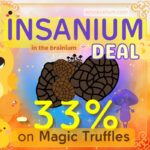For many, a trip comes with a good helping of Hendrix, Jefferson Airplane or The Beatles (post Indian adventure). Of course, you should listen to anything you want during your psychedelic trip— listen to Drake if thats your jam! But, if you fancy some melodic guidance for your next entheogenic adventure, you could do worse than letting science be your DJ.
A Playlist Made for Tripping
Luckily, a bona-fide scientist curated playlist is at your fingertips! In 2017 psychologist Bill Richards PH.D, developed a playlist of songs as a result of his psilocybin based research at the John Hopkins University. This institution is at the centre of the new wave of psychedelic research, pioneering studies that focus on the medicinal properties of psychotropic substances. In fact, last year, the university opened a new facility called Centre for Psychedelic and Consciousness Research. This centre is both the largest of its kind in the world, and the first of its kind in the U.S.
Music is a Vital Tool
In these studies, designed to investigate the effects of psilocybin on various mental health conditions, such as depression and OCD, participants are sometimes given high doses. This means that they can have an experience of great intensity, tripping and experiencing powerful sensations. Through his experience in running these studies, Richards came to see music as a vital tool in guiding the volunteers through their psychedelic journey.
A Heavy Dose of Mozart
In fact, Richards does not see the music chosen as something to groove along to. Rather, it acts as a support or stabiliser for the volunteer’s experience. There is nothing stereotypically ‘trippy’— no Dark Side of the Moon, or sitars. In fact, a large percentage of the songs featured in the playlist are classical— a heavy dosage of Mozart, Brahms and Bach is administered to the ears of the tripper. Only a few of the chosen songs feature lyrics. Roberts explains that the words of a song can distract the tripper’s brain, as it strains to clasp on to normality. By having music that is mainly instrumental (or features voice as an instrument rather than as a narrative tool) there is no distraction from the psilocybin doing its ‘thing’.
‘Nonverbal Support Network’
Additionally, the order of the songs is vital to the experience. Choreographed to the onset, build, peak and end of a trip, Roberts dubs the playlist a ‘nonverbal support network’. For example, at the peak of the trip, Brahm’s calming Violin Concerto is a balm to a potentially overwhelming experience.
“At a trip’s peak, music becomes a mirror of transcendental forms of consciousness that may not even be registered in unitive awareness, but is present if needed — like a net below a trapeze artist”
The playlist lasts for the standard length of a trip, featuring as well as classical, world and ambient music too. The full playlist can be found on Spotify and various Youtube channels. Listen to it here, for an aural experience whether tripping or not!
And To Play You Out…
Towards the end of the playlist, timed for when the tripper would start the journey back to normality, songs with lyrics begin to feature. Roberts states that at this point the volunteer could listen to anything they might find enjoyable or comforting. His recommendation however, is pretty apt for your return to Earth — Louis Armstrong’s ‘What a Wonderful World’.

 INSANIUM Deal
INSANIUM Deal 

 Combo deals >
Combo deals >

 Hálás köszönet érte!
Szuperek vagytok!
Hálás köszönet érte!
Szuperek vagytok!
 Strength up to 110/100
Strength up to 110/100 
 %
%
 500 gr.
500 gr. 
